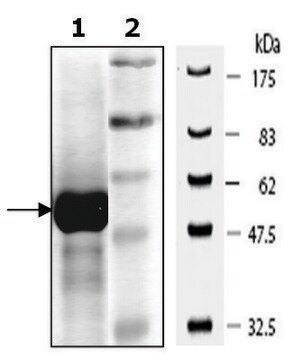MAK072
Pyruvate Kinase Activity Assay Kit
sufficient for 100 colorimetric or fluorometric tests
About This Item
Prodotti consigliati
impiego
sufficient for 100 colorimetric or fluorometric tests
Metodo di rivelazione
colorimetric
fluorometric
Malattie correlate
hematological disorder; cancer
Temperatura di conservazione
−20°C
Descrizione generale
The Pyruvate Kinase Activity Assay Kit provides a simple and direct procedure for measuring pyruvate kinase activity in a variety of biological samples. Pyruvate concentration is determined by a coupled enzyme assay, which results in a colorimetric (570 nm)/ fluorometric (λex = 535/λem = 587 nm) product, proportional to the pyruvate present. One unit of pyruvate kinase is the amount of enzyme that will transfer a phosphate group from PEP to ADP to generate 1.0 μmole of pyruvate per minute at 25 °C.
Applicazioni
Compatibilità
Principio
Sostituito da
Avvertenze
Danger
Indicazioni di pericolo
Consigli di prudenza
Classi di pericolo
Aquatic Chronic 3 - Resp. Sens. 1 - Skin Sens. 1
Codice della classe di stoccaggio
10 - Combustible liquids
Certificati d'analisi (COA)
Cerca il Certificati d'analisi (COA) digitando il numero di lotto/batch corrispondente. I numeri di lotto o di batch sono stampati sull'etichetta dei prodotti dopo la parola ‘Lotto’ o ‘Batch’.
Possiedi già questo prodotto?
I documenti relativi ai prodotti acquistati recentemente sono disponibili nell’Archivio dei documenti.
I clienti hanno visto anche
Articoli
We presents an article about the Warburg effect, and how it is the enhanced conversion of glucose to lactate observed in tumor cells, even in the presence of normal levels of oxygen. Otto Heinrich Warburg demonstrated in 1924 that cancer cells show an increased dependence on glycolysis to meet their energy needs, regardless of whether they were well-oxygenated or not.
Il team dei nostri ricercatori vanta grande esperienza in tutte le aree della ricerca quali Life Science, scienza dei materiali, sintesi chimica, cromatografia, discipline analitiche, ecc..
Contatta l'Assistenza Tecnica.

